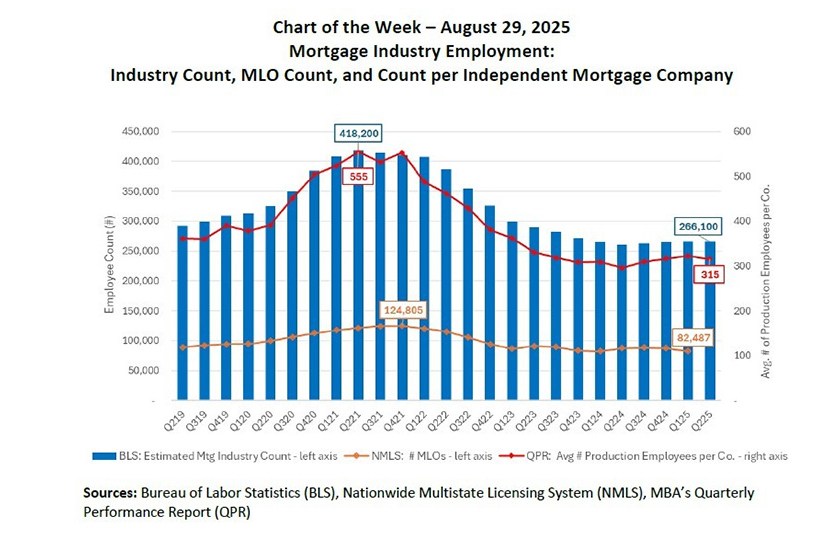
Chart of the Week: Mortgage Industry Employment

This Chart of the Week focuses on trends in mortgage industry employment and appropriately coincides with Labor Day and MBA’s upcoming Human Resources Symposium. In this chart, we focus on three different measurements of mortgage employment from three different sources.
Perhaps the most used and frequently cited metric for mortgage industry employment is from the U.S. Bureau of Labor Statistics (BLS). The displayed quarterly data are averages of the monthly released data from two main industry categories: real estate credit and mortgage and nonmortgage brokers. While not a perfect measurement, the BLS number of mortgage industry employees tracks closely with mortgage originations – peaking in 2021 at 418,200 employees then declining through the beginning of 2024 before stabilizing. From the second quarter of 2021 to the same quarter in 2025, the industry experienced a 36% decline.
Another employment data source is on the count of state licensed mortgage loan originators (MLOs). This data is available through the Nationwide Multistate Licensing System (NMLS) owned and operated by a subsidiary of the Council of State Bank Supervisors (CSBS). As mandated by the SAFE Act, the NMLS is used by non-depositories and depositories for licensing and registration purposes as well as tracking active mortgage loan originators – those that have originated at least one loan per quarter. Per the NMLS reporting, the number of MLOs declined by 34%, settling at about 82,500 MLOs in 2025 from a high of almost 125,000 MLOs in 2021.
Lastly, a third source for mortgage employment is MBA’s own Quarterly Performance Report (QPR) that tracks a variety of performance measurements based on data from about 325 independent mortgage banks (IMBs) and mortgage subsidiaries of chartered banks. Shown on the right axis of this chart is the average number of production employees (sales, fulfillment and production support employees) per company. The QPR percentage drop of 43% over the past 4 years is higher than the other estimates, likely driven by the type of companies in the QPR sample – independent mortgage companies who must adjust head count quickly to stay profitable without the advantage of other lines of business that banks and credit unions have.
These three different sources of data show a consistent trend – industry employment has stabilized in the past six quarters compared to the period of dramatic decline from 2021-2023. Loan originations are forecast to increase through 2027, which may also mean some modest pickup in mortgage industry employment.
To further explore trends in industry employment, employment law and human resources executive perspectives, register for the MBA’s Annual Human Resources Symposium taking place at MBA’s headquarters in Washington, D.C., on Sept. 9-10, 2025.
–Marina Walsh, CMB (mwalsh@mba.org)
